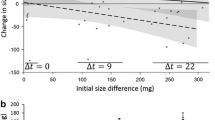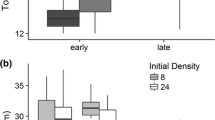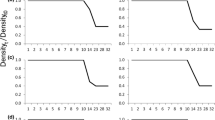Abstract
Populations of plants and animals are almost always made up of individuals of different sizes. In populations where cannibalism is common, this size variation can influence rates of mortality and growth and affect population regulation. Size variation can be caused by a variety of mechanisms. One of these is due to size-specific responses to the threat of predation by potentially cannibalistic conspecifics. We investigated the role of anti-predator behavior in size structure development within single-aged cohorts of Arizona tiger salamander larvae. In a laboratory experiment, we show that size variation increases over time within groups of salamanders, even if they are fed in isolation. We also show that increasing the size of neighbors decreases the feeding rate of small salamander larvae. However, increasing density of neighbors did not have a significant effect on feeding rate. These results are consistent with the hypothesis that size variation among tiger salamander larvae is, in part, a result of size-specific responses to predation risk. We discuss the potential for feedback between size structure development, predation risk, and rates of cannibalism.
Similar content being viewed by others
Author information
Authors and Affiliations
Additional information
Received: 5 October 1999 / Accepted: 8 February 2000
Rights and permissions
About this article
Cite this article
Ziemba, R., Myers, M. & Collins, J. Foraging under the risk of cannibalism leads to divergence in body size among tiger salamander larvae. Oecologia 124, 225–231 (2000). https://doi.org/10.1007/s004420050010
Issue Date:
DOI: https://doi.org/10.1007/s004420050010




